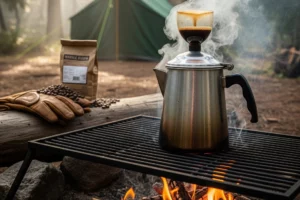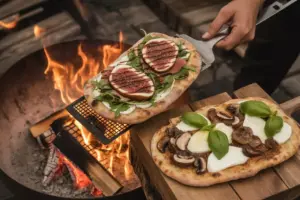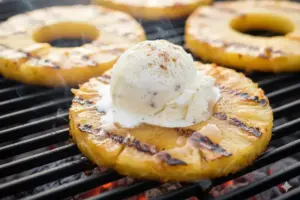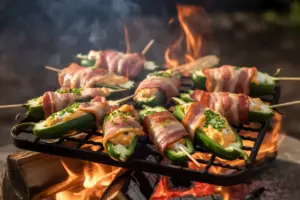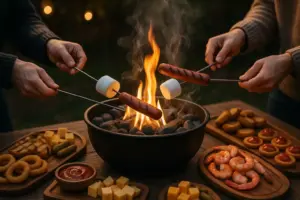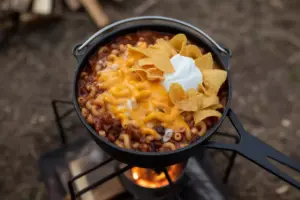5 Simple Ways to Elevate Your Camp Meals with Grilled Vegetables
Picture this: you’re sitting around a crackling campfire after a long day of hiking, and instead of opening another can of beans, you’re savoring perfectly charred vegetables that rival any restaurant dish. The secret? Learning how to roast vegetables on the grill transforms ordinary camping meals into extraordinary outdoor dining experiences that will have your fellow campers asking for seconds.
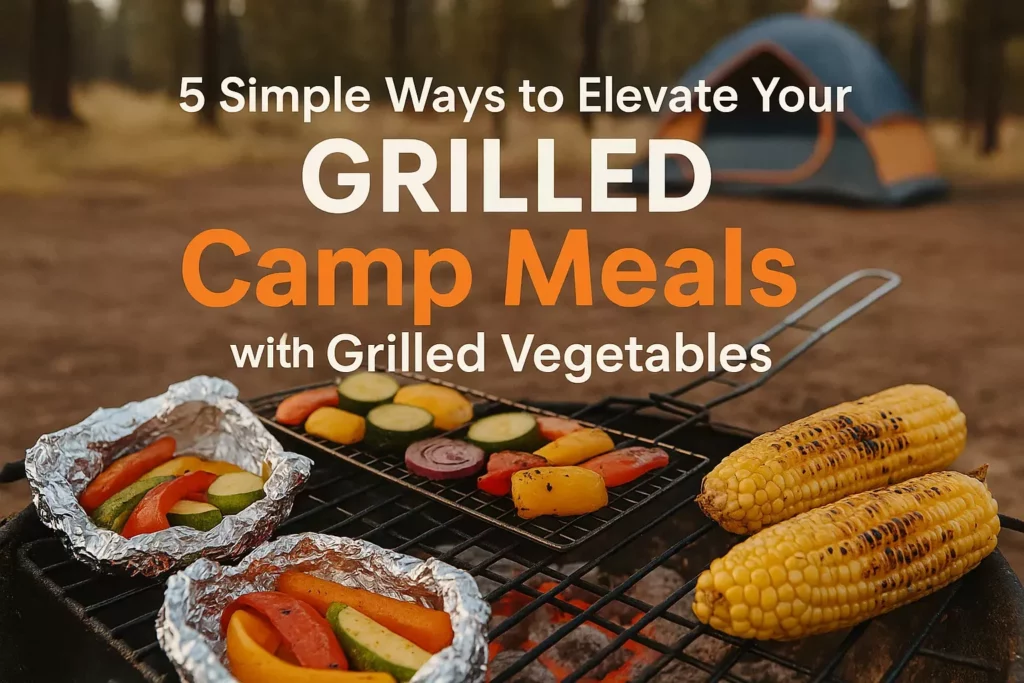
Grilling vegetables while camping isn’t just about adding nutrition to your outdoor menu—it’s about creating memorable moments and delicious flavors that enhance the entire camping experience. When you master the art of veggies roast techniques, you unlock a world of possibilities that can turn even the simplest ingredients into gourmet camp cuisine.
Key Takeaways
- Proper preparation is essential: Pre-cutting vegetables and using the right seasonings makes grilling easier and more flavorful
- Temperature control matters: Different vegetables require different heat levels and cooking times for optimal results
- Foil packets are your friend: They prevent small pieces from falling through grates and create perfect steam-cooking environments
- Timing is everything: Adding vegetables at the right moment ensures they’re perfectly cooked when your main dish is ready
- Simple tools make a big difference: A good grill basket and heavy-duty foil can elevate your vegetable grilling game significantly
1. Master the Art of Vegetable Foil Packets 🥕
One of the most foolproof methods to roast vegetables on the grill during camping trips involves creating perfectly sealed foil packets. This technique not only prevents vegetables from falling through grill grates but also creates a mini-oven effect that ensures even cooking and maximum flavor retention.
Creating the Perfect Foil Packet
Start with heavy-duty aluminum foil, cutting pieces approximately 12 inches long. The key to successful veggies roast packets lies in proper layering and sealing techniques. Place your prepared vegetables in the center of the foil, leaving enough space around the edges for proper sealing.
Essential foil packet tips:
- Use double layers of foil for longer cooking vegetables like potatoes
- Create a “drugstore wrap” by folding edges tightly to prevent steam escape
- Leave some headroom in the packet for steam circulation
- Add a tablespoon of oil or butter for enhanced flavor and moisture
Best Vegetables for Foil Packets
Not all vegetables perform equally well in foil packets. Root vegetables like carrots, potatoes, and onions work exceptionally well because they benefit from the steam-cooking environment. Bell peppers, zucchini, and mushrooms also excel in this cooking method.
Consider mixing vegetables with similar cooking times in the same packet. For example, combine diced potatoes with carrots and onions, or pair bell peppers with zucchini and mushrooms. This ensures everything finishes cooking simultaneously.
Seasoning and Flavor Combinations
Transform basic vegetables into gourmet side dishes with strategic seasoning. Mediterranean combinations using olive oil, garlic, oregano, and lemon juice work beautifully with most vegetables. For a southwestern flair, try cumin, chili powder, and lime juice.
Popular seasoning combinations:
- Italian: Olive oil, garlic, basil, oregano, parmesan cheese
- Mexican: Cumin, paprika, chili powder, lime juice, cilantro
- Asian-inspired: Sesame oil, soy sauce, ginger, garlic
- Classic herb: Butter, thyme, rosemary, salt, pepper
When camping with kids, involve them in the packet-making process. Children love helping with food preparation, and foil packets are safe and easy for small hands to assist with.
2. Utilize Grill Baskets for Perfect Vegetable Medleys 🧺
Grill baskets revolutionize how you roast vegetables on the grill by providing direct heat access while preventing smaller pieces from disappearing into the flames. These versatile tools allow for better caramelization and that coveted smoky flavor that makes grilled vegetables irresistible.
Choosing the Right Grill Basket
Invest in a quality grill basket with fine mesh or small holes that prevent vegetables from falling through while allowing maximum heat exposure. Stainless steel baskets with long handles work best for camping situations, as they’re durable and easy to maneuver over hot coals.
Look for baskets with the following features:
- Non-stick coating for easy cleanup
- Secure latching mechanism to keep vegetables contained
- Long handles for safe maneuvering over hot grills
- Adequate size to accommodate your typical group size
Preparation Techniques for Grill Baskets
The secret to successful veggies roast in grill baskets lies in uniform cutting and proper oil distribution. Cut vegetables into similar-sized pieces to ensure even cooking. Toss vegetables with oil before placing them in the basket—this prevents sticking and promotes beautiful caramelization.
Pre-cooking considerations:
- Partially pre-cook dense vegetables like potatoes or carrots
- Pat vegetables dry to promote browning
- Don’t overcrowd the basket—work in batches if necessary
- Preheat the grill basket for 2-3 minutes before adding vegetables
Timing and Temperature Management
Different vegetables require varying cooking times and temperatures. Start with longer-cooking vegetables like potatoes and carrots, then add quicker-cooking items like bell peppers and zucchini later in the process.
Cooking time guidelines:
- Root vegetables (potatoes, carrots): 15-20 minutes
- Dense vegetables (broccoli, cauliflower): 10-15 minutes
- Soft vegetables (zucchini, bell peppers): 5-10 minutes
- Delicate vegetables (mushrooms, tomatoes): 3-7 minutes
Remember that altitude and outdoor temperature can affect cooking times, so adjust accordingly based on your camping location. If you’re setting up camp for the first time, check out our guide on tent setup and camp organization to ensure your cooking area is properly arranged.
3. Direct Grilling Techniques for Robust Vegetables 🔥
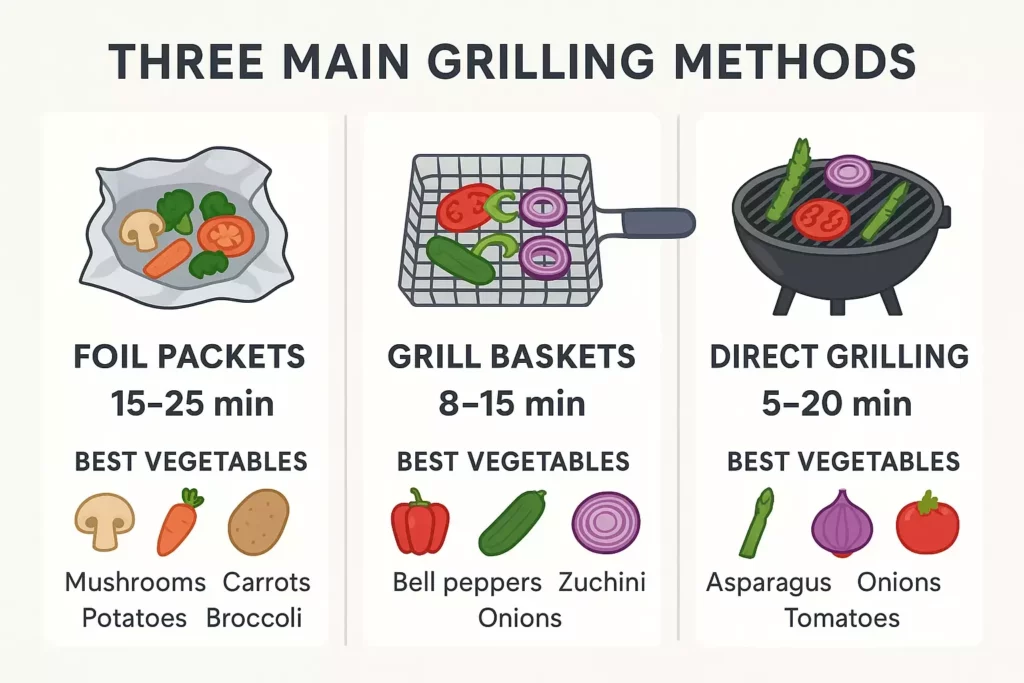
Some vegetables shine when placed directly on grill grates, developing beautiful char marks and intense flavors that can’t be achieved through other methods. Learning how to roast vegetables on the grill using direct heat techniques opens up possibilities for creating restaurant-quality sides in the great outdoors.
Best Vegetables for Direct Grilling
Large, sturdy vegetables work best for direct grilling. Corn on the cob, whole bell peppers, thick-sliced eggplant, and large mushroom caps are perfect candidates. These vegetables won’t fall through grill grates and can withstand high heat without falling apart.
Thick slices of vegetables like zucchini, yellow squash, and sweet potatoes also work well when cut to at least ½-inch thickness. The key is ensuring pieces are large enough to handle easily with tongs while maintaining structural integrity during cooking.
Preparation and Seasoning for Direct Heat
Proper preparation is crucial for successful direct grilling. Clean vegetables thoroughly and pat them completely dry—excess moisture prevents proper browning and can cause dangerous flare-ups.
Direct grilling preparation steps:
- Clean and dry vegetables thoroughly
- Cut to appropriate sizes (½-inch minimum thickness)
- Brush with oil to prevent sticking and promote browning
- Season generously before grilling for maximum flavor penetration
- Preheat grill grates to prevent sticking
For corn, try soaking husks in water for 30 minutes before grilling. This creates steam inside the husk while allowing the outside to char beautifully. Remove a few outer layers of husk but leave the inner layers intact for protection.
Managing Heat and Timing
Direct grilling requires active management to prevent burning while achieving proper doneness. Create heat zones on your grill—one area with high direct heat for initial searing and another with medium heat for finishing cooking.
Start vegetables over high heat to develop char marks and color, then move them to medium heat areas to finish cooking through. This two-zone approach ensures veggies roast properly without burning the exterior before the interior cooks.
Heat management tips:
- Rotate vegetables regularly for even cooking
- Move to cooler areas if browning too quickly
- Use a spray bottle to control flare-ups
- Test doneness with a fork—vegetables should be tender but not mushy
Having a well-organized camping kitchen setup makes managing multiple vegetables much easier and safer.
🔥 Interactive Vegetable Grilling Guide
4. Create Flavorful Marinades and Seasoning Blends 🌿
The difference between good grilled vegetables and extraordinary ones often lies in the marinades and seasonings used. Understanding how to roast vegetables on the grill with proper flavor enhancement transforms simple produce into memorable camp cuisine that rivals any restaurant dish.
Basic Marinade Foundations
A successful vegetable marinade requires three key components: acid, fat, and flavor. The acid (lemon juice, vinegar, or wine) helps break down tough fibers, the fat (olive oil or butter) carries flavors and prevents sticking, while herbs and spices provide the distinctive taste profiles.
Essential marinade ratios:
- 3 parts oil to 1 part acid for most vegetables
- 2 parts oil to 1 part acid for delicate vegetables like zucchini
- 4 parts oil to 1 part acid for dense vegetables like potatoes
Allow vegetables to marinate for at least 30 minutes, but no more than 2 hours for most varieties. Over-marinating can break down cellular structure, leading to mushy veggies roast results.
Regional Flavor Profiles
Different regional seasoning approaches can transport your camp meals around the world. Mediterranean marinades featuring olive oil, lemon, garlic, and herbs like oregano and thyme work beautifully with most vegetables.
Popular regional combinations:
- Mediterranean: Olive oil, lemon juice, garlic, oregano, thyme, salt
- Asian-inspired: Sesame oil, rice vinegar, soy sauce, ginger, garlic
- Mexican: Lime juice, olive oil, cumin, chili powder, cilantro
- Indian: Yogurt, lemon juice, garam masala, turmeric, ginger
- Moroccan: Olive oil, lemon juice, cinnamon, cumin, paprika, mint
Dry Rub Techniques
Sometimes the best approach for grilled vegetables involves dry rubs rather than wet marinades. Dry rubs work particularly well for vegetables with naturally high moisture content, as they won’t dilute the seasoning mixture.
Create dry rubs by combining salt, sugar (to promote caramelization), and various spices. Apply rubs 15-30 minutes before grilling to allow flavors to penetrate while drawing out excess moisture.
Versatile dry rub base:
- 2 tablespoons brown sugar
- 1 tablespoon coarse salt
- 1 teaspoon black pepper
- 1 teaspoon garlic powder
- 1 teaspoon onion powder
- Additional spices based on desired flavor profile
When preparing meals outdoors, having pre-mixed seasoning blends saves time and ensures consistent flavoring throughout your camping trip.
Storage and Application Tips
Pre-mix seasoning blends at home and store them in small, labeled containers for easy camping transport. This preparation saves time at the campsite and ensures you have everything needed for delicious grilled vegetables.
Apply marinades and seasonings just before cooking for maximum flavor impact. If marinating longer, store vegetables in a cooler with proper ice management to maintain food safety standards.
5. Perfect Timing and Temperature Control 🌡️
Mastering timing and temperature control separates amateur vegetable grilling from professional-level results. Understanding how to roast vegetables on the grill with precise heat management ensures perfectly cooked vegetables every time, regardless of your camping setup.
Understanding Heat Zones
Create multiple heat zones on your grill to accommodate different vegetables simultaneously. This technique allows you to start dense vegetables over high heat while having medium and low heat areas available for finishing cooking or keeping completed vegetables warm.
Heat zone setup:
- High heat zone: Direct flames or coals for initial searing
- Medium heat zone: Moderate heat for main cooking
- Low heat zone: Gentle heat for warming or finishing
- Cool zone: No direct heat for resting completed vegetables
Test heat zones using the hand method—hold your hand 5 inches above the grate and count how long you can keep it there. One to two seconds indicates high heat, three to four seconds medium heat, and five or more seconds low heat.
Vegetable Cooking Sequences
Plan your grilling sequence based on cooking times, starting with vegetables requiring the longest cooking periods. This ensures everything finishes simultaneously, preventing some vegetables from overcooking while others remain underdone.
Typical cooking sequence:
- Start first: Root vegetables (potatoes, carrots, beets)
- Add second: Dense vegetables (broccoli, cauliflower, thick squash)
- Add third: Medium vegetables (bell peppers, onions, corn)
- Add last: Quick-cooking vegetables (zucchini, mushrooms, tomatoes)
Temperature Monitoring Techniques
While camping, you may not have access to sophisticated temperature monitoring equipment. Learn to judge doneness through visual cues, texture testing, and timing guidelines.
Doneness indicators:
- Visual: Nice char marks, vibrant colors, slight caramelization
- Texture: Tender when pierced with a fork but not mushy
- Timing: Follow established guidelines but adjust for altitude and weather
- Internal temperature: 185-200°F for most vegetables when measured with a thermometer
Remember that vegetables continue cooking slightly after removal from heat, so err on the side of slight undercooking rather than overcooking.
Weather and Altitude Adjustments
Outdoor cooking requires adjustments based on environmental conditions. Cold weather, wind, and high altitude all affect cooking times and heat management when learning how to roast vegetables on the grill.
Environmental adjustments:
- Cold weather: Increase cooking times by 25-50%
- Windy conditions: Use windbreaks and check food more frequently
- High altitude: Reduce cooking times and increase liquid in foil packets
- Humid conditions: Extend cooking times for proper moisture evaporation
Having proper weather-appropriate clothing ensures you can comfortably manage your grilling regardless of conditions.
Essential Equipment and Setup Tips 🛠️
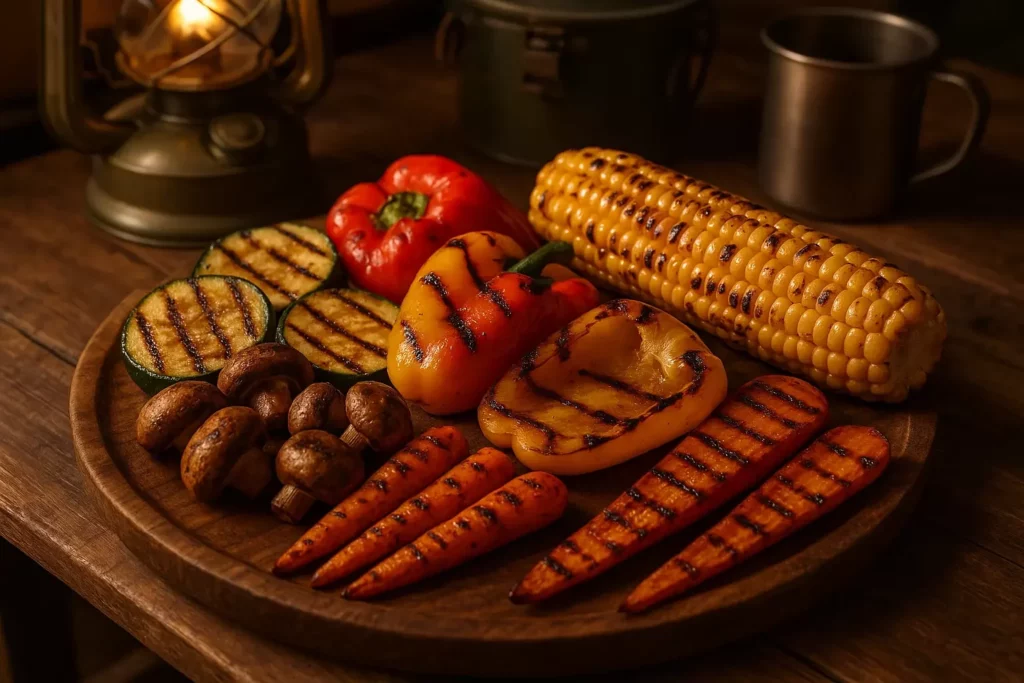
Success in grilling vegetables while camping depends heavily on having the right equipment and proper setup. Understanding what tools are essential versus nice-to-have helps you pack efficiently while ensuring you can execute all veggies roast techniques effectively.
Must-Have Grilling Tools
Invest in quality, multi-purpose tools that serve multiple functions while camping. A good set of long-handled tongs, a sturdy spatula, and a reliable grill brush form the foundation of any camping grilling toolkit.
Essential equipment list:
- Long-handled tongs (12+ inches) for safe maneuvering
- Wide spatula for flipping and moving large vegetables
- Grill brush for cleaning grates between uses
- Heavy-duty aluminum foil for packet cooking
- Grill basket with fine mesh for small vegetables
- Sharp knife and cutting board for prep work
- Large mixing bowl for tossing vegetables with oil and seasonings
Campsite Setup Considerations
Proper campsite setup makes vegetable grilling safer and more enjoyable. Position your grill in an area protected from wind but with adequate ventilation, away from tents and other flammable materials.
Ensure you have adequate workspace near your grill for food preparation and plating. A camp table positioned at the right distance provides convenient access without being too close to heat sources.
Setup safety tips:
- Position grill on level, stable ground
- Keep a well-stocked first aid kit nearby
- Have water or sand available for emergency fire suppression
- Ensure adequate lighting for evening cooking
- Keep raw and cooked foods properly separated
Cleaning and Maintenance
Maintaining clean equipment while camping requires planning and the right supplies. Bring biodegradable soap, scrub brushes, and plenty of water for cleaning tools and surfaces.
Clean grill grates while they’re still warm for easier removal of stuck-on food. Soak grill baskets and tools in warm, soapy water immediately after use to prevent food from hardening and becoming difficult to remove.
Safety Considerations and Food Handling 🛡️
Grilling vegetables while camping requires attention to food safety principles, especially when dealing with limited refrigeration and outdoor cooking conditions. Proper food handling ensures your delicious grilled vegetables don’t lead to foodborne illness during your outdoor adventure.
Temperature Safety Guidelines
Maintain proper food temperatures throughout the preparation, cooking, and serving process. Keep raw vegetables cold until ready to cook, and don’t leave prepared vegetables at room temperature for more than two hours (one hour if ambient temperature exceeds 90°F).
Food safety temperatures:
- Refrigeration: Keep vegetables below 40°F until cooking
- Cooking: Most vegetables should reach 185-200°F internal temperature
- Serving: Don’t leave cooked vegetables out longer than 2 hours
- Storage: Refrigerate leftovers within 2 hours of cooking
Cross-Contamination Prevention
Prevent cross-contamination by using separate cutting boards, utensils, and storage containers for vegetables and raw meats. This is especially important when grilling multiple items simultaneously.
Prevention strategies:
- Use color-coded cutting boards (green for vegetables, red for meat)
- Designate specific tongs and spatulas for vegetables only
- Wash hands thoroughly between handling different foods
- Store vegetables in separate containers from raw meats
- Clean all surfaces with sanitizing solution between uses
Water Safety and Cleaning
Ensure you have access to clean water for washing vegetables and cleaning equipment. If camping in remote areas, know how to purify water for drinking and cooking to maintain food safety standards.
Wash all vegetables thoroughly before cutting or cooking, even if you plan to peel them. Dirt and bacteria on the outside can contaminate the inside during cutting.
Nutritional Benefits and Meal Planning 🥗
Incorporating grilled vegetables into your camping meals provides significant nutritional benefits while adding variety and flavor to outdoor dining. Understanding these benefits helps you plan balanced, satisfying meals that fuel your outdoor adventures.
Nutritional Advantages of Grilled Vegetables
Grilling vegetables preserves more nutrients compared to boiling or other high-water cooking methods. The high heat and short cooking times help retain vitamins and minerals while developing complex flavors through caramelization.
Key nutritional benefits:
- Vitamin retention: Grilling preserves heat-sensitive vitamins better than boiling
- Fiber content: Vegetables provide essential dietary fiber for digestive health
- Antioxidants: Colorful vegetables offer protective compounds and antioxidants
- Low calories: Most vegetables are naturally low in calories but high in nutrients
- Mineral content: Grilling doesn’t leach minerals like water-based cooking methods
Meal Planning Integration
Plan your camping meals to include grilled vegetables as both sides and main dish components. This approach ensures balanced nutrition while maximizing the versatility of your camping cooking setup.
Meal planning strategies:
- Breakfast: Add grilled vegetables to scrambled eggs or breakfast burritos
- Lunch: Create grilled vegetable wraps or salads
- Dinner: Serve as sides with grilled proteins or as vegetarian main dishes
- Snacks: Grilled vegetable chips or seasoned vegetable medleys
When planning family camping activities, involving children in vegetable preparation and grilling teaches valuable cooking skills while encouraging healthy eating habits.
Portion Planning and Preparation
Calculate appropriate vegetable portions based on your group size and activity level. Active campers typically need larger portions to fuel their outdoor activities, while sedentary camping may require smaller amounts.
General portion guidelines:
- Side dish: 1/2 to 3/4 cup cooked vegetables per person
- Main dish: 1 to 1.5 cups cooked vegetables per person
- Snacks: 1/4 to 1/2 cup cooked vegetables per person
- Mixed dishes: 1/3 to 1/2 cup vegetables combined with other ingredients
Troubleshooting Common Grilling Problems 🔧
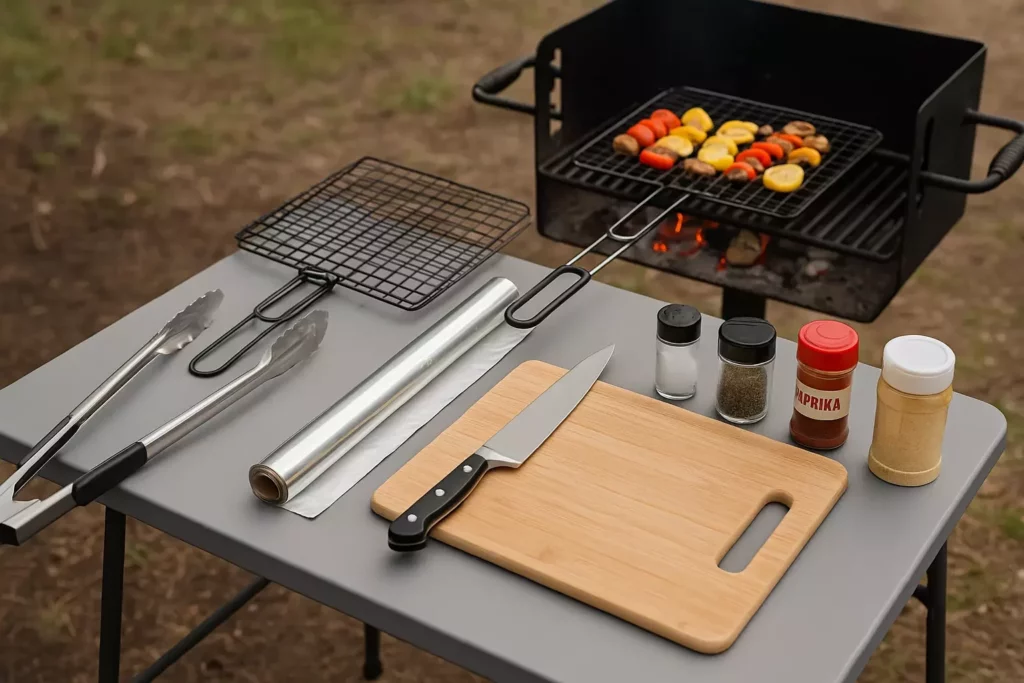
Even experienced campers encounter challenges when grilling vegetables outdoors. Understanding common problems and their solutions helps you adapt quickly and still produce delicious results regardless of circumstances.
Vegetables Falling Through Grates
This common frustration occurs when vegetable pieces are cut too small or when grill grates have wide spacing. Prevention involves proper sizing and using appropriate tools for different vegetables.
Solutions:
- Cut vegetables to minimum 1/2-inch thickness
- Use grill baskets for small or irregularly shaped pieces
- Create foil packets for tiny vegetables like cherry tomatoes
- Skewer small vegetables to create larger, manageable pieces
- Use a perforated grill pan designed for vegetables
Uneven Cooking Results
Uneven cooking typically results from inconsistent heat distribution, overcrowding, or mixing vegetables with vastly different cooking times.
Corrective measures:
- Create and maintain proper heat zones
- Cook similar vegetables together in batches
- Cut vegetables to uniform sizes
- Rotate vegetables regularly during cooking
- Use a two-stage cooking process for dense vegetables
Sticking and Burning Issues
Vegetables stick to grates when they’re not properly oiled, grates aren’t clean, or heat is too high for the vegetable type.
Prevention techniques:
- Clean and oil grates before cooking
- Brush vegetables with oil before grilling
- Preheat grates properly before adding food
- Use appropriate heat levels for each vegetable type
- Don’t move vegetables too soon—let them develop a crust first
Weather-Related Challenges
Outdoor cooking presents unique weather challenges that indoor cooking doesn’t face. Wind, cold, and precipitation all affect grilling performance and safety.
Weather adaptations:
- Use windbreaks to maintain consistent heat
- Adjust cooking times for cold weather conditions
- Have backup indoor cooking options for severe weather
- Protect food preparation areas from precipitation
- Monitor fuel consumption more carefully in cold weather
When facing challenging conditions, having proper camping gear organization helps you quickly access needed tools and supplies.
Advanced Techniques and Creative Applications 🎨
Once you’ve mastered basic vegetable grilling techniques, explore advanced methods and creative applications that can transform your camp cooking from functional to exceptional. These techniques help you roast vegetables on the grill with restaurant-quality results.
Smoking Techniques for Vegetables
Add wood chips to your camping grill to infuse vegetables with subtle smoky flavors. Different wood types provide distinct flavor profiles that complement various vegetables.
Wood pairing suggestions:
- Apple wood: Sweet vegetables like corn, sweet potatoes, carrots
- Cherry wood: Bell peppers, tomatoes, eggplant
- Hickory: Mushrooms, onions, potatoes
- Cedar planks: Asparagus, zucchini, delicate vegetables
Soak wood chips for 30 minutes before use, then wrap in foil with holes poked through for controlled smoke release.
Stuffed Vegetable Techniques
Large vegetables like bell peppers, zucchini, and eggplant can be hollowed out and stuffed with grains, other vegetables, or proteins for complete one-dish meals.
Stuffing preparation:
- Hollow vegetables carefully, leaving walls thick enough to maintain structure
- Pre-cook dense stuffing ingredients partially
- Season stuffing mixtures well, as flavors will meld during grilling
- Use foil tents to prevent over-browning while ensuring thorough cooking
Vegetable Grilling for Meal Prep
Grill large batches of vegetables for use throughout your camping trip. Properly grilled and stored vegetables can enhance multiple meals and reduce daily cooking time.
Meal prep strategies:
- Grill vegetables slightly underdone for reheating later
- Store in airtight containers with proper refrigeration
- Use grilled vegetables in salads, wraps, and grain bowls
- Incorporate into breakfast dishes and snacks
- Freeze portions for longer camping trips
Creative Presentation Ideas
Elevate your camp dining experience with thoughtful presentation techniques that make grilled vegetables more appealing and Instagram-worthy.
Presentation tips:
- Arrange vegetables by color for visual appeal
- Use natural garnishes like fresh herbs
- Serve on wooden boards or camp-appropriate serving dishes
- Create vegetable kabobs for easy eating and attractive presentation
- Drizzle with flavored oils or balsamic reductions
Conclusion
Mastering the art of grilling vegetables while camping transforms ordinary outdoor meals into extraordinary culinary experiences. From the simplicity of foil packets to the sophistication of direct grilling techniques, learning how to roast vegetables on the grill opens up endless possibilities for delicious, nutritious camp cuisine.
The five techniques covered—foil packets, grill baskets, direct grilling, flavor enhancement, and proper timing—provide a comprehensive foundation for vegetable grilling success. Whether you’re a beginner setting up your first camping experience or an experienced outdoor cook looking to expand your skills, these methods ensure consistently excellent results.
Remember that successful veggies roast techniques require practice, patience, and adaptation to your specific camping conditions. Start with simple preparations and gradually incorporate more advanced techniques as your confidence and skills develop.
Your next steps:
- Plan your next camping menu incorporating at least two vegetable grilling techniques
- Gather essential equipment including grill baskets, heavy-duty foil, and quality tools
- Practice at home to perfect timing and seasoning combinations before your trip
- Experiment with different vegetables and flavor profiles to discover your favorites
- Share your knowledge with fellow campers to spread the joy of excellent outdoor cooking
The memories created around a campfire enhanced by delicious, perfectly grilled vegetables will last long after the embers have died down. Every camping trip becomes an opportunity to explore new flavors, share great food with loved ones, and prove that outdoor cooking can rival any restaurant experience.

